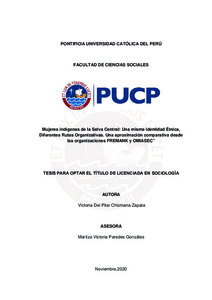| dc.contributor.advisor | Paredes Gonzales, Maritza Victoria | |
| dc.contributor.author | Chicmana Zapata, Victoria Del Pilar | |
| dc.date.accessioned | 2021-01-17T00:33:30Z | |
| dc.date.available | 2021-01-17T00:33:30Z | |
| dc.date.created | 2020 | |
| dc.date.issued | 2021-01-16 | |
| dc.identifier.uri | http://hdl.handle.net/20.500.12404/17854 | |
| dc.description.abstract | Esta investigación es un estudio comparativo subnacional sobre cómo en un
mismo territorio (provincias Satipo y Chanchamayo) emergen dos rutas
organizativas de mujeres indígenas amazónicas. Los casos de estudio son: la
OMIASEC, Organización de Mujeres Indígenas de la Selva Central (organización
paralela, perteneciente a una organización indígena mixta, la CECONSEC,
Central de Comunidades Nativas de la Selva Central) y la FREMANK,
Federación Regional de Mujeres Asháninka, Nomatsiguenga y Kakinte (una
organización independiente, fuera de las organizaciones mixtas). Se busca
explicar por qué estas dos organizaciones han conformado distintas rutas
asociativas en un mismo territorio. Para ello, se analizan los mecanismos que
permiten que estas organizaciones emerjan y se mantengan, así como la
creación de significados en torno al cual se fundan. Se halla que ambas
organizaciones poseen un proceso de formación similar: necesitan un ambiente
político favorable, identifican como causa común la necesidad de un espacio de
representación para las mujeres y pasan por un proceso de legitimación frente
al movimiento indígena. No obstante, la diferencia significativa es que las dos
organizaciones surgen en tiempos diferentes. El tiempo no solo plantea un
momento cronológico, sino histórico, con diferentes contextos sociopolíticos para
estas organizaciones y los actores aliados trabajando con ellas. Cuando surge
la FREMANK, entre finales de la década de 1990 e inicios del 2000, las
organizaciones indígenas de Satipo estaban debilitadas por el conflicto armado
y recién se estaban abriendo a la participación de las mujeres, aunque existían
ONGs dispuestas a apoyar las iniciativas de una organización de mujeres. Por
lo tanto, las mujeres de la FREMANK se organizan independientemente y fundan
su propia federación. En cambio, cuando surge la OMIASEC, en el periodo de
2012- 2014, las organizaciones indígenas estaban más fortalecidas y
familiarizadas con la participación de las mujeres indígenas y como se
interseccionan los temas de género con la agenda indígena. Como
consecuencia, la OMIASEC se configura como paralela a una organización
indígena mixta, la CECONSEC. | es_ES |
| dc.description.abstract | This research is a sub-national comparative study on how in the same territory
(Satipo and Chanchamayo provinces) emerge two organizational routes of
Amazonian indigenous women. The case studies are: OMIASEC, Organización
de Mujeres Indígenas de la Selva Central (parallel organization, that belongs to
a mixed indigenous organization, the CECONSEC, Central de Comunidades
Nativas de la Selva Central) and the FREMANK, Federación Regional de Mujeres
Asháninka, Nomatsiguenga y Kakinte (an independent organization, outside of
mixed organizations). The research aims to explain why these two organizations
have formed different associative routes in the same territory. We analyze the
mechanisms that allow these organizations to emerge and remain, as well as the
creation of meanings around which they are founded. We found that both
organizations have a similar formation process: They need a favorable political
environment, they identify as a common cause the need for a space of
representation for women, and they go through a process of legitimation in the
face of the indigenous movement. However, the significant difference is that the
two organizations arise at different times. Time not only implies a chronological
moment, but also a historical one, with different socio-political contexts for these
organizations and the actors working with them. When FREMANK emerged,
between the late 1990s and early 2000s, the indigenous organizations of Satipo
were weakened by the armed conflict and were just opening up to the
participation of women, but there were NGOs willing to support the initiatives of
a women's organization. Therefore, the women of the FREMANK organize
independently and create their own federation. On the other hand, when
OMIASEC emerged, in the period 2012-2014, indigenous organizations were
more strengthened and familiar with the participation of indigenous women and
how gender issues intersect with the indigenous agenda. As a consequence,
OMIASEC is configured as parallel to a mixed indigenous organization,
CECONSEC. | es_ES |
| dc.language.iso | spa | es_ES |
| dc.publisher | Pontificia Universidad Católica del Perú | es_ES |
| dc.rights | Atribución 2.5 Perú | * |
| dc.rights | info:eu-repo/semantics/openAccess | es_ES |
| dc.rights.uri | http://creativecommons.org/licenses/by/2.5/pe/ | * |
| dc.subject | Mujeres indígenas--Perú--Selva Central | es_ES |
| dc.subject | Pueblos indígenas--Perú--Selva Central | es_ES |
| dc.subject | Movimientos sociales--Perú--Selva Central | es_ES |
| dc.title | Mujeres indígenas de la Selva Central: Una misma identidad étnica, Diferentes rutas organizativas. Una aproximación comparativa desde las organizaciones FREMANK y OMIASEC | es_ES |
| dc.type | info:eu-repo/semantics/bachelorThesis | es_ES |
| thesis.degree.name | Licenciado en Sociología | es_ES |
| thesis.degree.level | Título Profesional | es_ES |
| thesis.degree.grantor | Pontificia Universidad Catolica del Peru. Facultad de Ciencias Sociales | es_ES |
| thesis.degree.discipline | Sociología | es_ES |
| renati.advisor.dni | 06783131 | |
| renati.advisor.orcid | https://orcid.org/0000-0002-1032-1356 | es_ES |
| renati.author.dni | 71213026 | |
| renati.discipline | 314086 | es_ES |
| renati.juror | Sulmont Haak, David Jose Antonio | |
| renati.juror | Delgado Pugley, Deborah | |
| renati.juror | Paredes Gonzales, Maritza Victoria | |
| renati.level | https://purl.org/pe-repo/renati/level#tituloProfesional | es_ES |
| renati.type | http://purl.org/pe-repo/renati/type#tesis | es_ES |
| dc.publisher.country | PE | es_ES |
| dc.subject.ocde | http://purl.org/pe-repo/ocde/ford#5.04.01 | es_ES |






